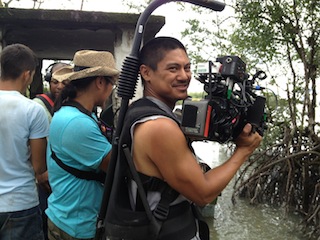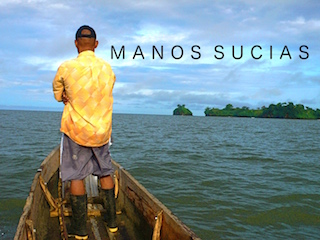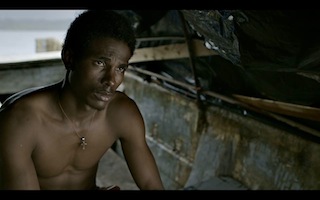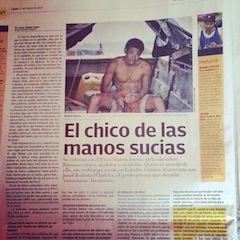 Alan Blanco says he thinks of himself “as a filmmaker first” and it’s understandable why. For someone still so early in his career he’s had a wide range of craft jobs on a long list of films. His IMDB credits list includes gaffer, key grip, camera operator, sound recordist, editor, sound editor and ADR engineer. Now, he’s added two more credits: screenwriter and cinematographer. Blanco co-wrote Manos Sucias, a widely acclaimed independent feature film with director Josef Kubota Wladyka and shot the film on location in Colombia. The film opens in select New York theatres April 3.
Alan Blanco says he thinks of himself “as a filmmaker first” and it’s understandable why. For someone still so early in his career he’s had a wide range of craft jobs on a long list of films. His IMDB credits list includes gaffer, key grip, camera operator, sound recordist, editor, sound editor and ADR engineer. Now, he’s added two more credits: screenwriter and cinematographer. Blanco co-wrote Manos Sucias, a widely acclaimed independent feature film with director Josef Kubota Wladyka and shot the film on location in Colombia. The film opens in select New York theatres April 3.
The film was made possible by grants from the Spike Lee Fellowship Award, the Film Independent Producing Fellowship, the Film Independent Canon Filmmaker Award, two SFFS/KRF Grants, private investments, and a healthy Kickstarter backing, which raised more than $60,000 for the production.
Manos Sucias (dirty hands) follows estranged brothers as they risk everything for a chance at a better life. Brothers Jacobo (Jarlin Martinez) and Delio (Cristian Advincula) both live in Buenaventura but haven’t seen each other in years. Their estrangement ends when a gang of drug traffickers selects them for a coveted, but hazardous, assignment. With a cocaine-filled torpedo and the charge to deliver it up the Colombian coast to a set of mysterious coordinates, their reunion is more business than reconciliation. The reward for their success is high; but first they must contend with the dangers of a region fraught with political unrest and powerful organized crime, not to mention the perils of the dark and stormy landscape itself.
The two brothers are a study in opposites: naïve, impressionable Delio dreams of becoming a famous rapper and providing his infant son with the glamorous lifestyle that accompanies such a career; meanwhile, his hardened older brother Jacobo has already lost a son to the brutal paramilitaries who roam the area and wants only to be able to put together enough money to move away and put Buenaventura behind forever. As their job becomes complicated by various factors – including a surprise search from the coast guard, a panicked detour created by an opportunistic thief, and an intense chase that leads to Delio’s first encounter with murder – the gravity of their grim situation sets in and their dreams of a better future float further out of reach.
The basic story was inspired by an eye-opening journey that director Wladyka took to South America in 2010. Blanco and Wladyk met in 2007 as students in New York University’s Graduate School of Film and Television. “We saw the story the same way,” Blanco said and they decided to collaborate. They worked together on the script on and off from 2010-2012. They wrote the film in English but Blanco said much of the on-screen dialogue is in Colombian Spanish.
Refusing to follow conventions by glamorizing the drug trafficking industry, the filmmakers instead created an unprecedented level of authenticity by asking the Buenaventura community itself to collaborate in the telling of the dramatic narrative. As a result, Buenaventura is one of the central characters in the film.
 When Blanco, Wladyka, and producer Elena Greenlee were on their first scouting trip in the area, they quickly realized life on the coastline could change in an instant. From month to month, different villages would be overtaken by armed conflict, plagued by the continuous presence of guerillas and paramilitaries. The tension on the ground was palpable.
When Blanco, Wladyka, and producer Elena Greenlee were on their first scouting trip in the area, they quickly realized life on the coastline could change in an instant. From month to month, different villages would be overtaken by armed conflict, plagued by the continuous presence of guerillas and paramilitaries. The tension on the ground was palpable.
As they traveled from village to village, the production team often felt like interlopers because the locals were dealing with the arduous task of rebuilding their communities once the armed conflict dissipated. They were highly suspicious towards outsiders. In order to build trust among the residents, the Manos Sucias team and their guides went door to door to find that community’s leader. They then held impromptu meetings about bringing the production to the township.
While most of the locals welcomed to the vision of the film and the production as a whole, they all invariable had one question: what would Manos Sucias bring to the community in return? Aside from standard location fees, the feeling among the crew was universal: their main value was not financial; instead, they would be much more impactful if they could leave the people of Buenaventura with lasting skills.
To accomplish that, the crew set up a five-week storytelling workshop, held every Saturday during pre-production. The team made an open call to invite community members to participate in the all-day-long seminars, much to the excitement of the locals. One community leader even asked for a digital camera instead of a location fee as trade to allow the production to film in his municipality.
Blanco said that one local that Wladyka enlisted was particularly invaluable for the production. Manuel Viveros is the theatrical director of a local Buenaventura theatre troupe. The cast for Manos Sucias ultimately came from that group and Viveros was credited as casting director on the movie.
 In all, a diverse group of 25 became the core of the storytelling workshops, ranging from young university students to the people in the theater troupe in their 40s and 50s. After the five-week intensive course, where students learned basic camera techniques, how to structure storylines, and how to edit in camera on their cell phones, many were hired on as production assistants.
In all, a diverse group of 25 became the core of the storytelling workshops, ranging from young university students to the people in the theater troupe in their 40s and 50s. After the five-week intensive course, where students learned basic camera techniques, how to structure storylines, and how to edit in camera on their cell phones, many were hired on as production assistants.
Manos Sucias began principal photography in April 2013. Thanks to the Canon grant, Blanco was shooting with a Canon EOS C300 Cinema and lenses. One of his first challenges was the fact that it was the first time that any of the actors had ever acted on camera. The EOS C300 is a small camera, Blanco said, “but it’s still intimidating.” He and Wladyk addressed that with lots of rehearsal time, which did the trick. “They could forget about the camera,” Blanco said.
Their three-week shoot was divided into two distinct locations. Week one focused on the city’s barrio section. Weeks two and three covered the brothers’ journey in the open ocean.
In both locations the weather and conditions were unpredictable. Sometimes the same day could bring sunshine or heavy rain. One day the tide would come in three hours early or got out an hour late.
Blanco said there were several places they couldn’t visualize beforehand and other places that were too beautiful not to use. They stayed flexible. “Since we wrote the script we knew the blocking we wanted from the actors,” he said. He shot using mainly prime lenses but “we were able to cover ourselves with zooms.”
I asked Blanco if they shared dailies with the performers and he said they decided against it.
 “For one thing,” he explained, “it wasn't particularly practical on the water. We had tight quarters in the boat so there wasn't room for big monitors. Having them huddle around me to watch playback on a tiny LCD screen really wouldn't have worked well either and also slowed us down. As for when we went back to home base, we were all so tired and had a lot to prepare for the next day that I think it wasn't on anyone's mind. Only Joe, the producers, Márcia Nunes, and Elena Greenlee would review what we got that day to make notes and adjustments for the next one. Though the actors, Cristian and Jarly are trained actors, they had never performed for the camera before. Neither of them asked to see footage and I think they just wanted to remain focused on themselves. They really put a lot of trust and faith in Joe and allowed themselves to be vulnerable and open for the camera. With that trust, I think viewing dailies wasn't necessary.”
“For one thing,” he explained, “it wasn't particularly practical on the water. We had tight quarters in the boat so there wasn't room for big monitors. Having them huddle around me to watch playback on a tiny LCD screen really wouldn't have worked well either and also slowed us down. As for when we went back to home base, we were all so tired and had a lot to prepare for the next day that I think it wasn't on anyone's mind. Only Joe, the producers, Márcia Nunes, and Elena Greenlee would review what we got that day to make notes and adjustments for the next one. Though the actors, Cristian and Jarly are trained actors, they had never performed for the camera before. Neither of them asked to see footage and I think they just wanted to remain focused on themselves. They really put a lot of trust and faith in Joe and allowed themselves to be vulnerable and open for the camera. With that trust, I think viewing dailies wasn't necessary.”
Every filmmaker has one or two shots on every project that are personally special. Some that happen are surprises; some are carefully planned. I asked Blanco to name his.
“The final shot of the Buenaventura y Caney scene is special to me,” he said “The story of that scene and its creation is the story of how I got on the project, actually. Throughout Joe's research, a few different characters were on the mission. They were strangers just on a job. While just chatting with him about the material I had the notion that even though they were strangers, they needed something that connected them. We tossed a few ideas around and ended up finding Buenaventura y Caney by Grupo Niche. The scene plays well in Colombia and to people who have a personal connection and nostalgia to the song. The circular shot at the end of the scene isn't like any other shot in the film. It's joyful, a little unrestrained, and we were lucky enough to get it at magic hour. How that shot feels, how it works with the song to resurrect joy in these characters amidst their terrible situation is very special to me.”
